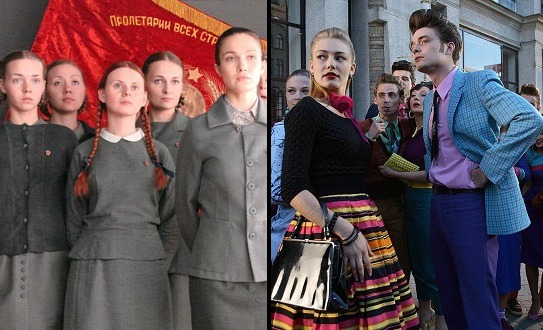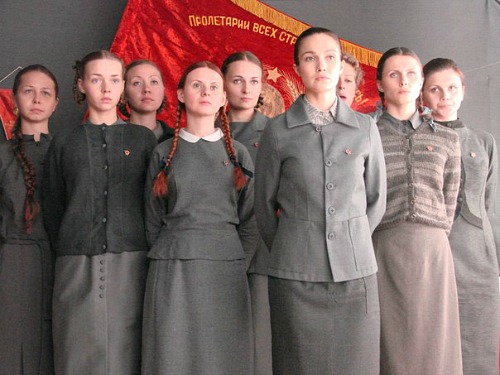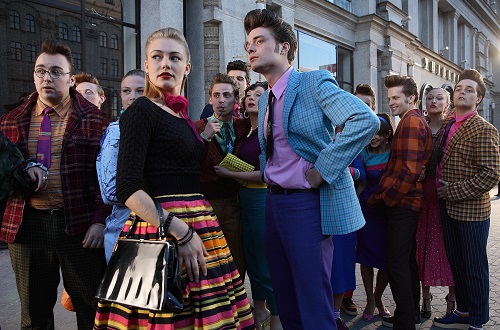
It’s an ancient story of opposites: yin and yang, light and darkness, sweet and sour, cheap and chic, communism and capitalism. Though seemingly direct opposites, they contain traces, little droplets of each other and, if taken to the extreme, provoke the same reactions. Or do they?
The USSR of 1950s was too conservative and practical for something as frivolous and diverse as fashion. Clothing choices were made by special committees and so, as designers complained, only the most generic models reached the public. The best dressed citizens were the ones who made their own clothes using dress patterns from scarce fashion magazines.
The Iron Curtain separating the country from Western influences didn’t make an exception for fashion trends. Even the ones to cross the barrier were met with disapproval: skirt length was monitored in schools and colleges, wearing pants was considered masculine and inappropriate for women, and high heels were “too impractical.” Dior’s first fashion show in the USSR shows a striking difference between the citizens and models. For most Soviet people during this time, fashion didn’t even exist.
Today’s “hipster” movement finds value in rareness – in the effort you put in to find something precious just for yourself. It is an answer to the mass availability of anything at all. But could it be that its background takes us back to the USSR of 1950s, a time of deficit and conformity, a time most different from the lavish shopping scene of contemporary ‘Murica?
Table of Contents
Back to the USSR

Well, gray is always on trend. | From the movie Stilyagi (2008)
When The Beatles sang “Back in the USSR/ You don’t know how lucky you are, boy,” they sure as hell didn’t mean the Soviet fashionistas. If you were a USSR college girl in the 1920-30s, you wouldn’t find a single flapper dress on sale. Even later on people had no choice but to wear what everyone else was wearing.
In fact, it was common to have a prom dress identical to your schoolmate’s. Feminine charm is not necessary for building communism, is it? On the contrary, the razzle dazzle doesn’t make one look like a trustworthy comrade. The factories were instructed to meet the quota, make the clothes last long and be comfortable. That is all.
In Soviet Russia you don’t use fashion to create an identity, because you don’t really need one. In Soviet Russia if you have time to make yourself pretty, you’re not working hard enough. In Soviet Russia the adjective “sexy” doesn’t have a meaning, because, as everyone knows, there is no sex in the USSR. This meme suddenly got really sad.
But of course, wherever there is a movement, there is a counter-movement. Grandfather Lenin (as Soviet children were taught to call the old man) would be disappointed to know about the riot, the love for everything American that crept about on tiptoes through the wall of isolation to flourish into the absurd, beautiful, exaggerated, romanticized movement, the much more daring predecessor of all this casual hipsteria.
Did You See the Stylish Kids in the Riot?

That hair. Can I join? | From the movie Stilyagi (2008)
One summer night in 1956, in a dark alleyway somewhere in St. Petersburg, when you’re walking home from the communist party meeting, a strange man in a hat may call you.
“Psst, hey kid, wanna buy some Belgian jeans?” (No brands, just countries: Belgian, American, Italian. All of these meant quality clothes)
Please, dear reader, resist the temptation to squander three salaries on those jeans. Yes, every single comrade will envy you, but those jeans stand for everything our system despises. Enticing, I know.
Soviet hipsters, also known as “stilyagi“ (from the word “style” or “steal,” no one really knows) didn’t care for the system. They recreated their own America from the splinters of Hollywood movies, rare imports, and illegal tunes of mischievous jazz.
They hung around the main street of their town(s) calling it “Broadway,” and making self-respecting citizens cross the road to the other side. They made rusty vinyl records from random people’s X-ray pictures and called them “boogie-woogie on bones.” Their parties were the greatest, their make-up the brightest, and their vocabularies filled with Americanisms. But really, how far would you go to get your hands on some foreign fashions?
It seems like for some Soviet youths, the answer was “pretty damn far.” After all, at the time, everyone regarded the “stilyag”-s as an abomination: lazy, capitalistic, and vain. Oh, and don’t get caught buying or selling illegal items or you’ll face actual problems with the law. Even more enticing, I know.
Of course, the stilyags’ America never existed. It was an anachronism, a movie world, too bright, too surreal, but still spoke the ever enchanting anthem of youthful freedom and personality.
Then and Now
USSR was a world of deficit. The US is a world of overproduction. Yet somehow both stilyags and hipsters look(ed) for and value(d) everything hard to find. Handmade, vintage, foreign, rare… Do the counter-worlds provoke similar responses? Does the modern hipster have a stilyag for a granddad? Tell us your opinion in the comments, comrade.

Great article!
Nare, fashion and history!? You have, amazingly, combined my two favorite topics! I loved this article, never heard of stilyagi, and now I want to see this movie so much.
Looking forward to more posts like this soon!
Dana, thanks for the pronunciation help, it is very appreciated!!!
Hi!Thank you for this article . Actually, my parents lived in USSR and I saw this movie ,so I can tell you “stilyagi“ (sounds like “steal” ) means fashionistas ,not thieves . It’s the same meaning with ” style” .
That’s an interesting article, though in some ways exaggerated. Custom tailoring of clothes was quite common at that time.
Also, referring to this:
>> “stilyagi“ (from the word “style” or “steal,” no one really knows)
The word ‘steal’ doesn’t sound anywhere close to this in Russian, and the word style is ‘stil’ in Russian, so the origin shouldn’t be that questionable.
Thanks for your kind words everyone:)
Nare, this was an excellent article. Please post more like this soon!
Can we get more articles like this? I love it 🙂
Crazy interesting! You sure sucked in this history nerd 😛
This is an excellent article. I’ve never heard about Stilyagi, and now I’m really curious.
I hope you plan to write more articles about history/society/politics and its relationship with fashion.
Fashion and History, two of my favourite things! Please write more articles like this, this is absolutely fascinating!
Thanks a lot! All is right. I’m from Russia, and all of your text is very recognizable for me.
Julia.